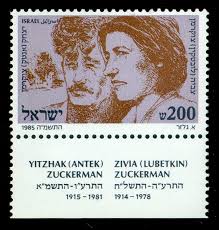Joe Freedman, Ed.D.
(In honor of International Holocaust Memorial Day, January 27)
“A good name is better than fragrant oil” (Ecclesiastes 7:1)
Did you know that Jerusalem has a street named: רחוב צביה ויצחק
“Rehov Tziviya ve-Yitzhak” (Zivia and Yitzhak street)? Jerusalem – as well as most cities in Israel – is super meticulous about naming streets. There are two very prestigious committees which makes decisions about the City’s street names, one headed by a former Supreme Court judge!
One can learn a lot by just walking down the streets of Jerusalem and paying attention to their names. Sometimes a street-sign gives a few word explanation of its name. Many street names memorialize personalities from Jewish and Zionist history (from Ruth to King David to King Agrippa to Theodor Herzl…). Some neighborhoods have street names with a common theme or period of history (the 12 Tribes, medieval Jewish scholars and poets…). In my neighborhood of Gilo (first established in 1971), walking through the streets you’ll mostly “meet” streets named for flowers, precious stones and spices (I live on Ha-Rosmarin – Rosemary – st.).
Among the few streets named for people in our neighborhood is “Zivia and Yitzhak Street.” Since moving to Gilo in 1982, I’ve always found that name to be strange. It’s rare that one street is named for two people (and using just first names at that), but I never bothered to do any research about it.
That changed just a few weeks ago: as I took a brisk walk down that street (which is actually the continuation of my own), I ran across a large mural, put up along where the new light railroad line is being built (see picture below). I did a double-take as I noticed that the mural showed a picture of:
ZIVIA and YITZHAK:
Zivia (Lubetkin) Zuckerman (1914-1978) and
Yitzhak Zuckerman (1915-1981)!
It turns out that they were true heroes of the Jewish People. In fact, the mural capsulizes the story of the couple in five short points. Following is a free translation (and explanation) of those points:

1. Zivia (nee Lubetkin) and Yitzhak (wartime codename: “Antek”) Zuckerman were among the leaders of the Jewish Partisans in Poland as well as of the Warsaw Ghetto Uprising (April-May, 1943 – they were two of the mere 34 survivors of that Uprising).
2. After World War II they looked after fellow Holocaust survivors and took part in establishing the “Bericha” (escape) network to smuggle survivors out of Europe and into Eretz Yisrael (the Land of Israel).
3. Zivia made Aliya (moved to Eretz Yisrael) in 1946, and was received as a national heroine. Yitzhak made Aliya in 1947 and was active in the memorializing of leaders of the ZOB (the Jewish Combat Organization in Poland during World War II).
4. Zivia and Yitzhak were writers. They testified at the trial of Adolf Eichmann (1961). They got married and had two children: Shimon and Yael.
5. They were among the founders of the Ghetto Fighters Kibbutz (Kibbutz Lohamei HaGheta’ot) as well as the Holocaust museum (Bet Lohamei HaGheta’ot) on the premises of the kibbutz.
Do you see what you can learn by just walking down the street?! For more details about these remarkable heroes, do some Googling! I just wanted to add to the five points that in 2001, their granddaughter, Roni Zuckerman, became the first female jet fighter pilot in the history of the Israeli Air Force.


May the memory of Zivia and Yitzhak be for a blessing. – יהי זכרם ברוך